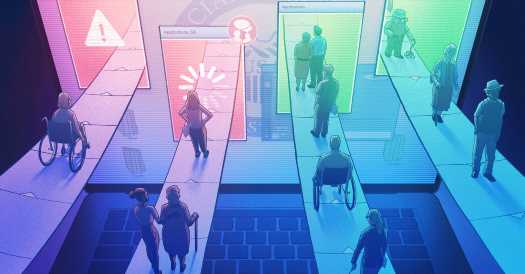
Social Security Is Rethinking How It Runs Customer Service After Covid
The pandemic abruptly closed the agency’s 1,200 offices, and officials are considering how to move forward. One issue: Without the offices, fewer low-income seniors sought benefits.
By Mark Miller
When the pandemic struck last year, the Social Security Administration shut down its national network of more than 1,200 offices as it scrambled to protect the public and its employees from the coronavirus.
The agency, which served 43 million visitors in those offices in 2019, was forced to meet immense technological and administrative challenges practically overnight as it shifted to an almost completely remote operation.
Social Security offices help older Americans with everything from retirement and Medicare claims to applications for disability insurance and Supplemental Security Income (S.S.I.), a benefit program for low-income disabled or older people. Yet even as Covid-19 cases decline and businesses and other public places reopen around the country, the timeline for a full reopening of the office network is uncertain. The agency is slowly bringing back workers in accordance with safety guidelines established by the federal government.
But operations are not likely to look the same as they did prepandemic, and a segment of S.S.A. workers may continue working remotely, a significant shift for the agency, which paid benefits to 69 million Americans in 2019.
“The pandemic provides a unique opportunity to consider how to improve service, increase virtual services and include the role of telework in the future,” said Mark Hinkle, an agency spokesman. “We are reviewing what we have learned and are working with our management team, unions and other stakeholders.”
Importantly, the volume of Social Security and Medicare benefit applications has not been affected during the pandemic — the number of applications from April 2020 through March of this year was 6.1 million, up a bit from the comparable period a year ago, agency records show. Wait times on the agency’s toll-free phone line — which have been notoriously long in some recent years — jumped during the first few months of the pandemic, but fell to much lower levels as most field office personnel were redeployed to handle business by phone. In March, the average wait time was 13.6 minutes, down from an average of 23.6 minutes for all of 2018, the year when backups peaked.
Social Security’s consideration of a larger role for telework is a sharp departure from its stance in November 2019, when it ended a work-from-home pilot program. In addition, it is expanding the use of “express interviews” at the offices, aimed at minimizing the time people need to spend there. Another change: a new option to enroll for Medicare Part B online, available to people 65 and up who lose jobs that provided health insurance. Previously, those applications needed to be made by phone or mail.
Source: Read Full Article
